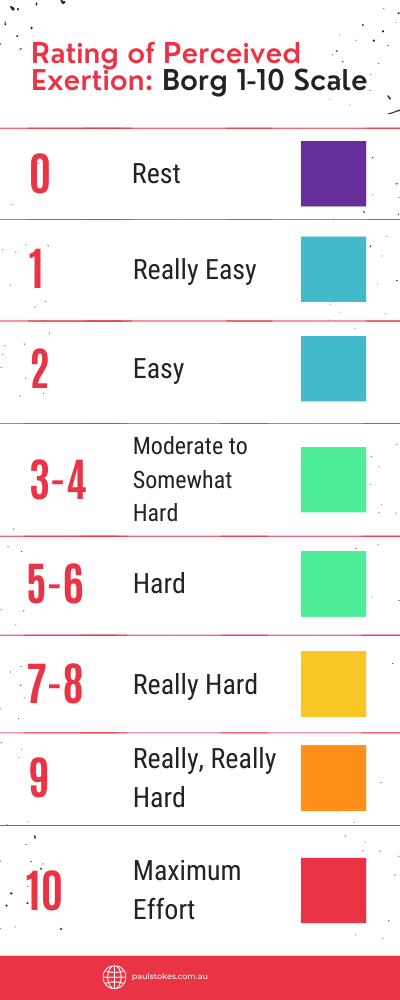I often have people approach me to ask "How hard am I supposed to be working?" There are several options. However, for me, the simplest and easiest way to monitor the intensity of your workout is using the talk test. There are no special equipment requirements and nothing too technical or difficult about it.
Sure, heart rate monitors can be useful tools. However, for the talk test you only really need to be able to breathe and talk.
More...
And that's the beauty of the talk test - it's how well you are able to breathe and talk at the same time that indicates how hard you're working.
Basically, the harder you work, the heavier your breathing becomes. The more breathless you get, the hard it will be for you to talk. At rest, you'll be able to talk in sentences. Just like normal everyday conversation.
As your heart rate increases and breathing gets heavier, your sentences will become shorter.
Further still, when you start breathing heavy, you'll only be able to spit out a few words at a time.
If you're at an all-out 100% workout intensity, you won't be able to speak at all.
By monitoring how you are able to talk, you can determine whether you're working out at a low, moderate, or high intensity.
Essentially, to get the most out of each cardio session, you want to be in at least a moderate intensity.
Practical Ways to Use the Talk Test in Your Workouts
Talk Test Option A: Favourite Poem or Song
During your workout, recite a favourite song or a poem that you know. Really, you can say anything you like.
Think to yourself how comfortably you can speak. If you can talk fairly easily, you're still at a low workout intensity. If talking's becoming difficult, then you're probably on at least a 5 on the RPE scale.
Talk Test Option B: Which number can you count up to?
Before you even begin exercising, count as high as you can on a single out-breath. That is to say, as you exhale, see what number you can count up to before you need to breathe in again.
As you work out, count again. Compare this number to the one from before the session. If you only make it to about 70% of the total you reached before exercise, you're currently at 5 or above on the perceived exertion scale.
Other Ways You Can Gauge and Judge Your Workout Intensity
Although the talk test mentioned above is probably the easiest way, there are other options you can use.
Using a Target Heart Rate
For this, you need a suitable heart rate monitor - preferably one with a chest strap transmitter. You also need to know what your target heart rate zone(s) are for the workout you'll be doing.
READ ALSO: How to Estimate your Maximum Heart Rate
It's just a case then of adjusting the intensity of your session as you go to keep your heart rate between the limits for your zone.
Monitoring Workout Intensity using the Rate of Perceived Exertion (RPE) Scale
Like the talk test, you don't need any special equipment for this one either.
In contrast, though, this method is a little more subjective than the talk test. You have to be honest with yourself and somewhat in tune with how you are feeling.
The basic idea is that you rank your current intensity on a scale of 0 to 10.
Zero would be sleeping, 1 would be sitting or lying down awake. On the other hand, an RPE of 10 would be like sprinting for your life out of a burning building.
By judging your own efforts based on how you feel, you can keep an eye on how hard your exercise session is.
Again, for effective cardio workouts, you're looking to stay somewhere between 5 and 9 on the RPE scale.

Use the modified Borg 1-10 RPE scale to monitor intensity and effort levels during exercise
The beauty of the RPE scale is that it's self-regulated and adapts to your current fitness level. In other words, as you become fitter, exercises that were challenging before feel easier.
Running at 9km/h may no longer feel like a 7 out of 10. It might only feel like a 5.
As a result, you'd need to run faster (i.e. increase the workout intensity) to reach 7 on the RPE scale again.
How Hard Should You Work During Your Exercise Sessions?
So, now you know these methods of tracking workout intensity, how hard you need to work?
Below are some suggestions for working out at various intensities:
Low-Intensity Sessions
Would be around 3-5 on the RPE Scale. This could be the intensity of your warm-up. Alternatively, it might be a long endurance workout so you want to pace yourself.
If you take walks throughout the day, this might be that intensity for you.
Moderate Intensity Workouts
You're now about 5, 6, or 7 on the RPE Scale. Ideally, most of your cardio workouts will fall within this range. If you were running next to your best mate, you could talk, but you'd struggle to hold a conversation.
You are only able to speak a few words at a time at this pace.
High-Intensity Exercise
Here, you're going to be about a level 8 or 9 RPE. Consequently, you can only work at this level for short bursts. Popular with interval training where you work hard for a short period then back off the intensity to recover.
You then push hard again and the cycle repeats.
You may have seen or heard of H.I.I.T. sessions. These High-Intensity Interval Training workouts are based around this pattern.
